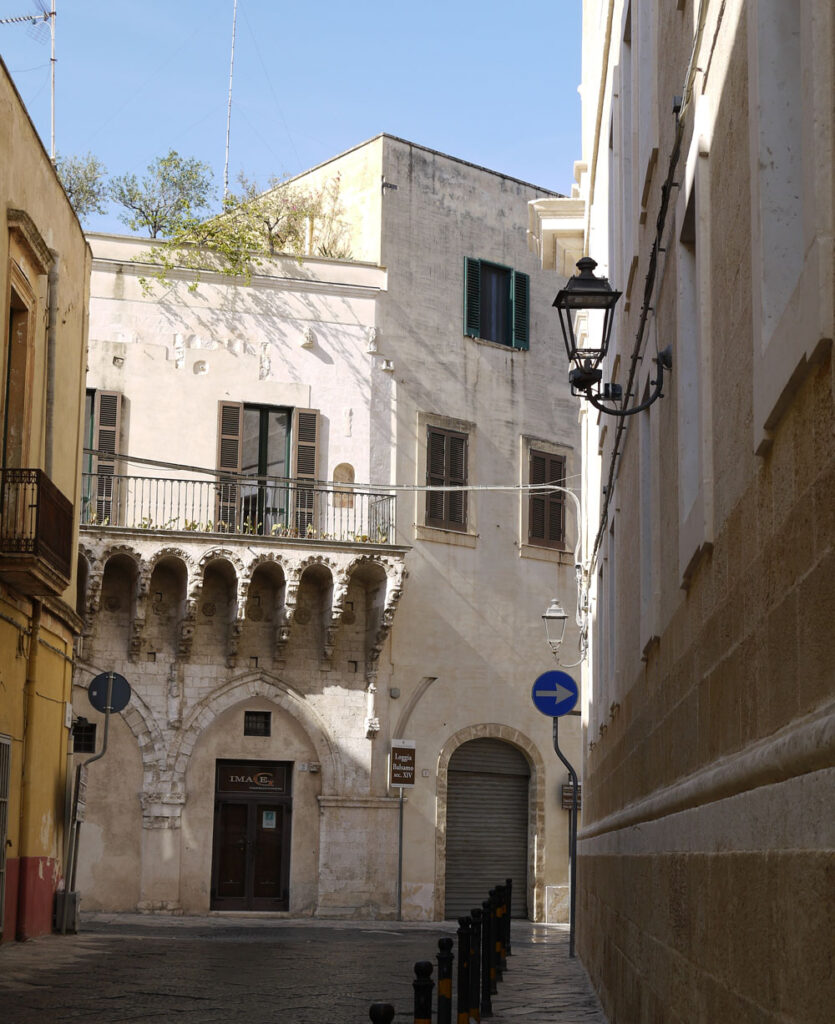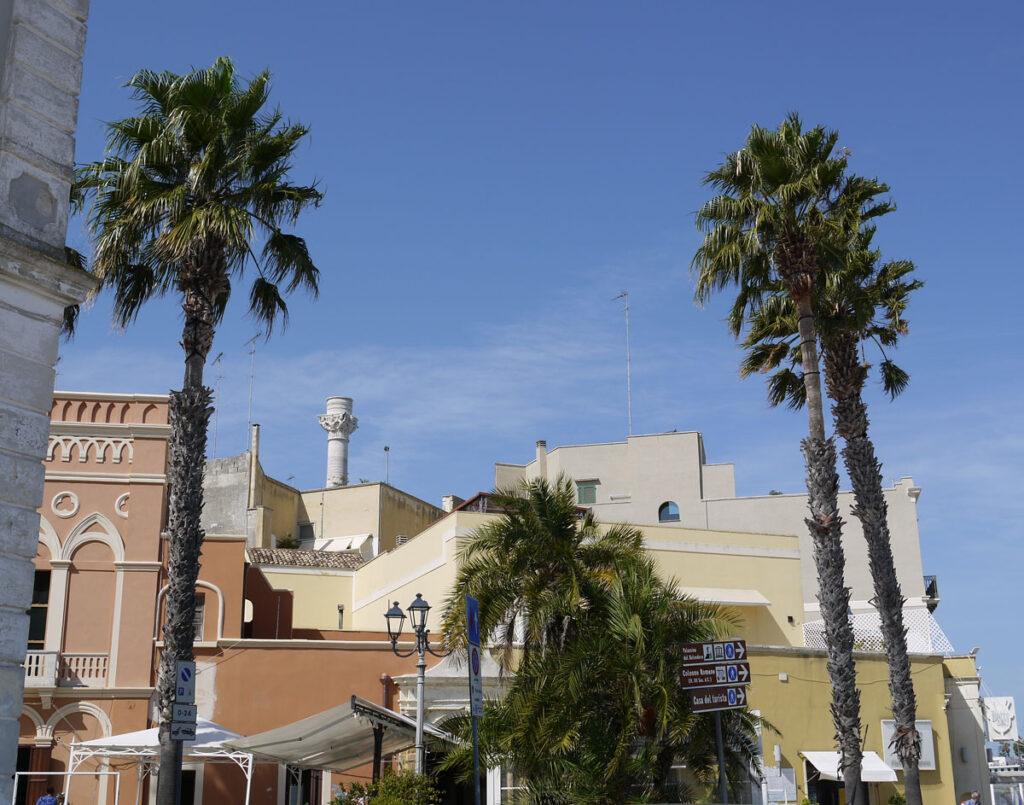Brindisi, a small port city in the southern Italian region of Puglia, is not renowned as a tourist destination. Famous local hotspots like Lecce and Ostuni get most of the attention from visitors. But Brindisi actually has a surprising amount to offer the traveller, combined with a refreshing untouristy feel. Brindisi international airport just outside the city is a gateway to this corner of Italy, and Brindisi’s public transport connections make it a useful travel hub. Although most passing travellers skip the city itself, its historic connections and sights are well worth a few hours – or more – sightseeing.
Wake up on a sunny day, take a walk along the waterfront with light dancing off the blue sea, visit the town’s most famous sight, marvel at the peace in an atmospheric historic church, discover Roman ruins then enjoy a delicious meal of Puglia’s speciality pasta or fresh seafood with a glass of local wine, and Brindisi feels a fine place to be. The city may not be the most beautiful or famous destination in Italy’s heel, but if you’re touring the area or flying to/from Brindisi airport, it is well worth stopping by or planning a strategic overnight stay with time to explore. I spent 24 hours in town before an evening flight and had a very enjoyable time.
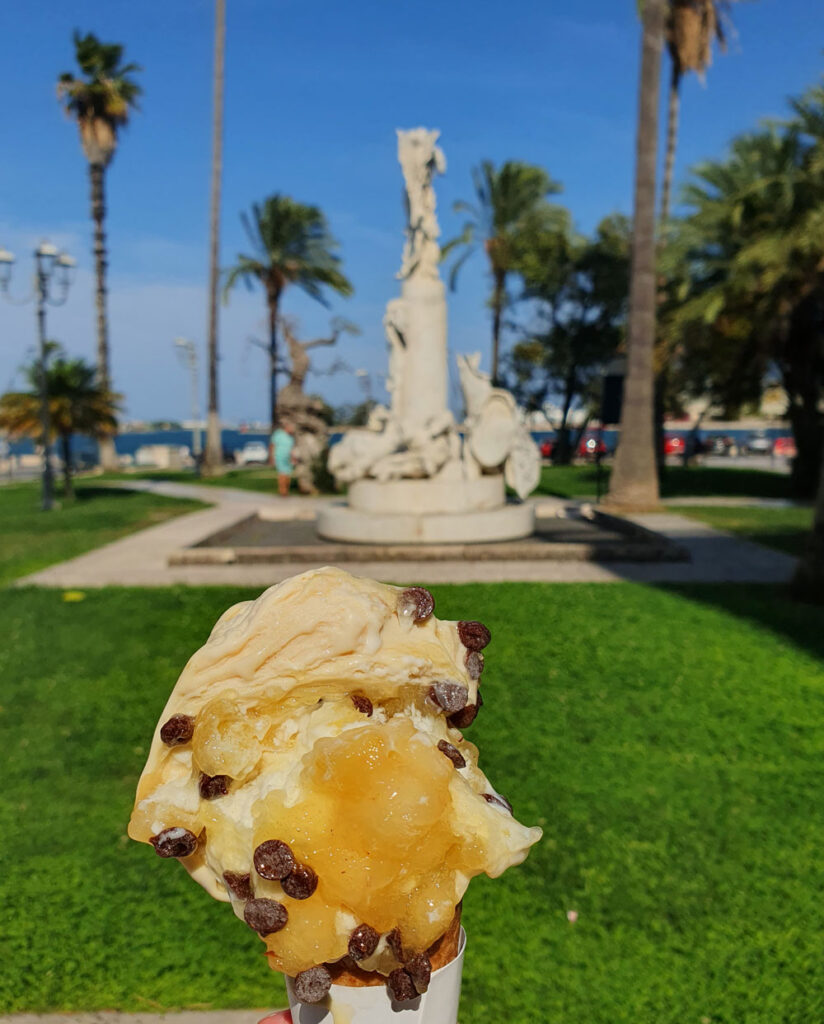
Why visit Brindisi?
- Historic associations – the end of the Appian Way
- Airport and good transport links
- Excellent archaeological museum
- Atmospheric temple church & other sights
- A refreshingly everyday, non-touristy atmosphere
Stay in Brindisi
I stayed very centrally in the Hotel Orientale on the city’s main high street between the railway station and sea. The interior had the time-slip feel of a business hotel from the 1980s. But though I wouldn’t say the hotel was especially charming, my bedroom had everything I needed, location was great, breakfast was an extensive buffet and staff were friendly and helpful. For a convenient and safe central base, where I could leave my luggage while sightseeing on foot, return to use facilities when needed, and catch the airport bus a few minutes away, it was an ideal practical choice.
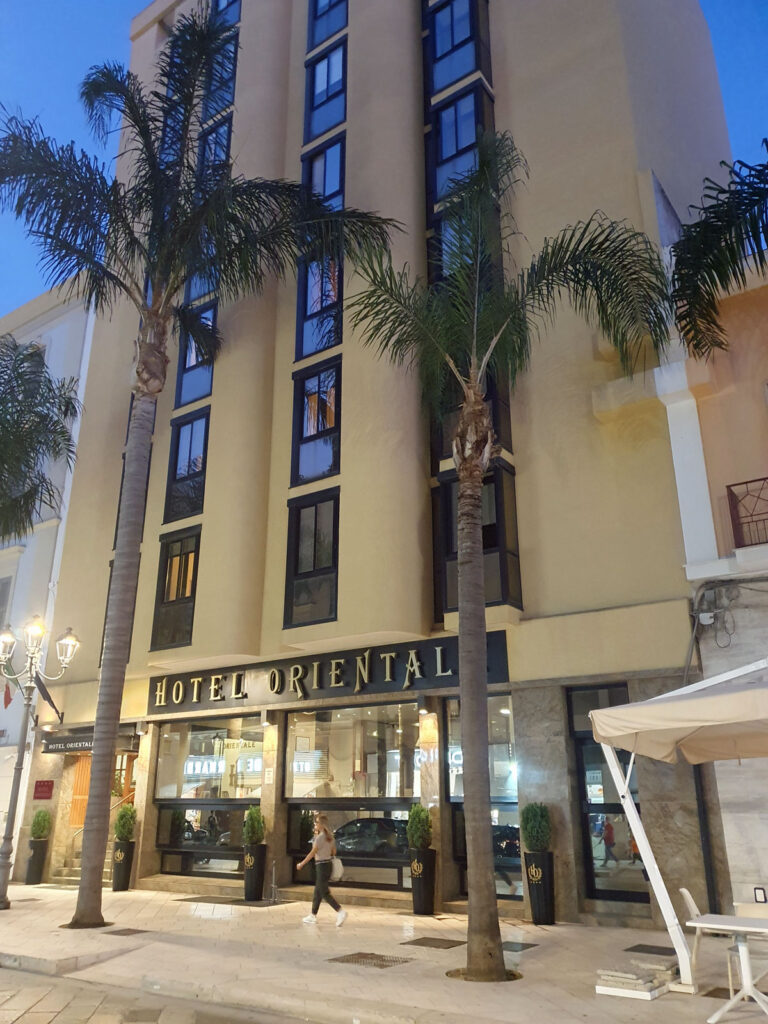
As well as a selection of fairly standard and chain hotels, there are also B&Bs in Brindisi where you’ll find a more boutique-y atmosphere and rooms with historic features, views and touches of luxury, generally at good-value prices.
> Find accommodation in and around Brindisi
Brindisi tourist information and history
Brindisi (pronounced with the stress on the first syllable), is sometimes called Italy’s Porta d’Oriente, Gateway of the East. It’s Italy’s most easterly port and has always been an immensely strategic centre for communications. You only need the quickest of looks at a map to understand why. A deep inlet in the coastline forms a natural ‘inner’ harbour, overlooked by the city on a central headland. It’s only a short distance across the Adriatic sea to Albania, and not much longer across the Ionian sea to Corfu, mainland Greece and the Mediterranean beyond; routes still used by shipping today.
The Messapians, then the Greeks, then the Romans all had important harbours here. For the Romans this was Brundisium, site of historic events including Julius Caesar’s battle with Pompey (a siege in which he blockaded the harbour entrance) and the Treaty of Brundisium, in which Caesar’s heir Octavian (the future Emperor Augustus) and Mark Anthony divided the Roman world between them.
To history-lovers the town is famous as the ending point of the Appian Way, the great Roman road which runs down southern Italy’s length from Rome. The tall column marking the end of the road overlooking the harbour is Brindisi’s most well-known tourist sight.
Over the last two thousand years Brindisi’s significance has grown and waned through earthquakes, military assaults and a silting-up harbour. The port was important for a long time as a departure point for the Holy Land, with crusaders, pilgrims and Knights Templar among those passing through and leaving their marks. In the 13th century the Emperor Frederick II, that huge figure in the history of the South, was married in the cathedral here, and built a great fortress overlooking the harbour.
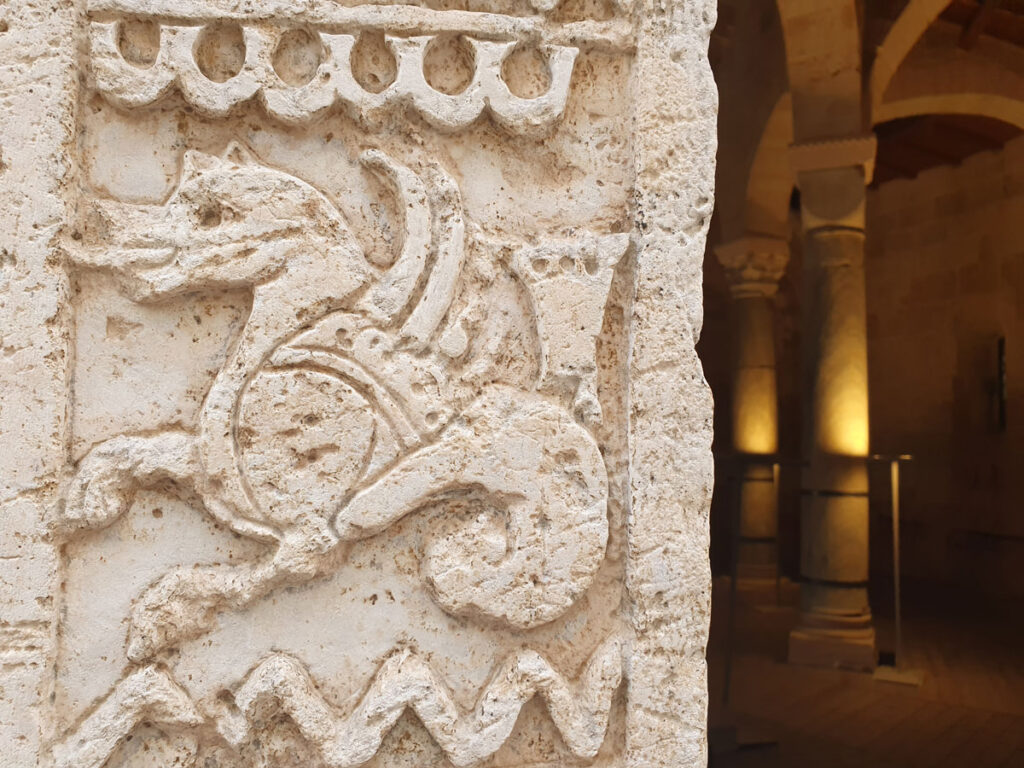
At the end of the 19th century and beginning of the 20th, after the opening of the Suez Canal, Brindisi enjoyed another period of prosperity as the port benefitted from its position on a fast rail-and-steamer mail route between London and India. The city’s central straight palm-lined boulevard still retains a turn-of-that-century air.
Brindisi was the site of Allied landings in World War II, and the city played an important part after Italy’s surrender. The country’s last King, Vittorio Emanuele III, its Prime Minister and other leaders fled here from Rome, the port was handed over to British control and Italy declared war on Germany. For a few months Brindisi became Italy’s capital.
Earlier the city had been subject to bombing raids by the British. Over the course of 1940-1941 the port city was targeted and suffered extensive damage (some photos here). In 2019 over 50,000 residents were briefly evacuated after an unexploded British bomb dropped in 1941 was discovered during the restoration of a cinema.
After its many vicissitudes over the centuries, including bombing in the First World War as well as the Second, Brindisi doesn’t have a handsome and intact historic centre to admire. Instead the city is a mixture of smarter and more down-at-heel modern streets dotted with occasional historic gems, bomb-damaged survivals of grander times and the kind of determination that has kept the maritime city surviving for so long.
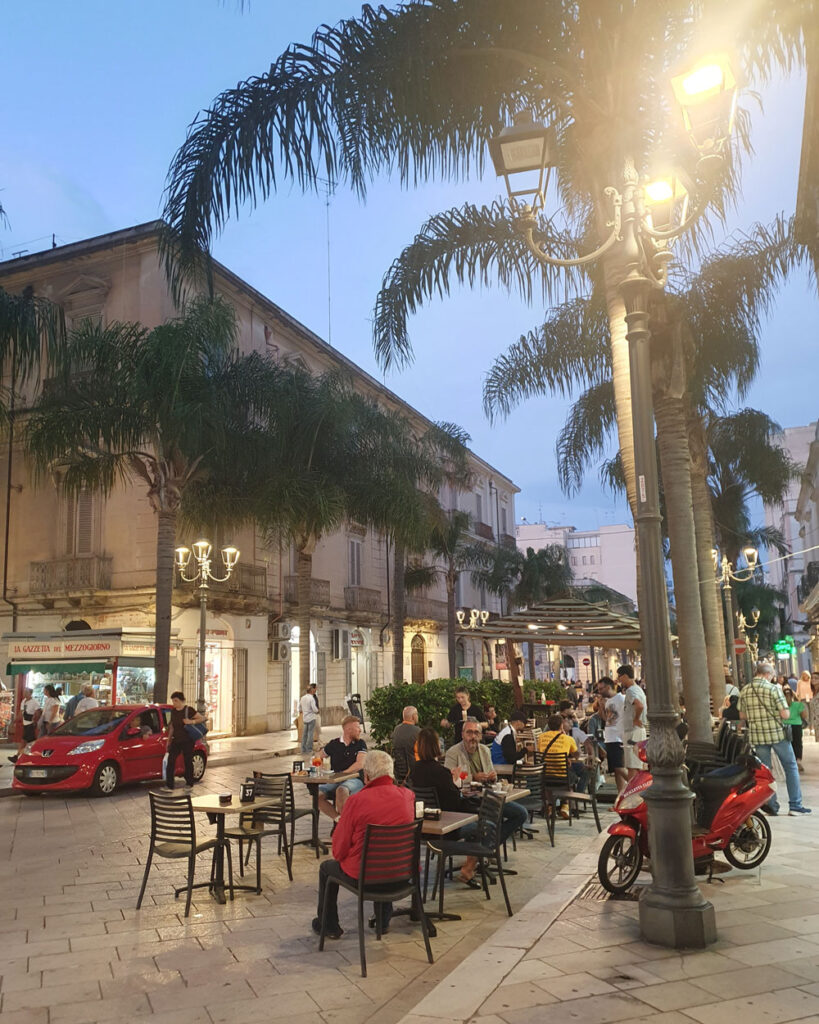
Things to do and see in Brindisi
Palazzo Granafei-Nervegna
The handsome 16th-century Palazzo Granafei-Nervegna on Via Duomo is a good first destination when you’re exploring Brindisi. There’s a tourist information office in the building as well as one of the town’s most important sights: the original stone capital which topped the famous harbourside Roman column.
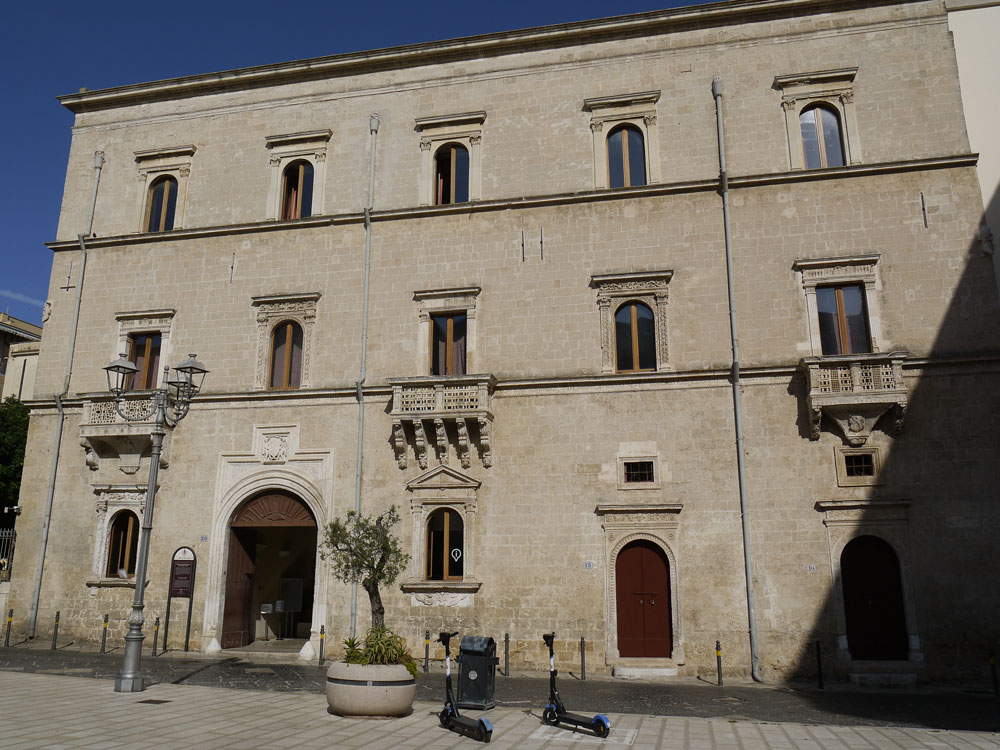
This is a fine late-Renaissance palace, one of a few survivors which give an idea of how much elegance Brindisi must have lost as a consequence of fire, earthquake and bombing over the centuries. The little square opposite contains some picturesque remains of more old buildings.
When I visited I found a very helpful staff member in the tourist office, who gave me a map, circling important sights and noting their opening times (always important to check in Italy due to early/lunchtime closures), and was also able to sell me a ticket for the airport bus. Perhaps because he was pleased by my level of interest, he also gave me a little tourist book about the province, the Terra di Brindisi.
Inside, beyond the courtyard and free to visit, is a display of column fragments as well as excavations from earlier buildings on the site, dating back as far as the Roman city. The greatest sight here, though, lies through a couple of rooms to the left: the huge capital of the Colonna Romana, the Roman column, one of the twin columns which once dominated the waterfront nearby. Grandly displayed, with helpful information boards on the walls, this is an awe-inspiring sight, impressive in its scale.
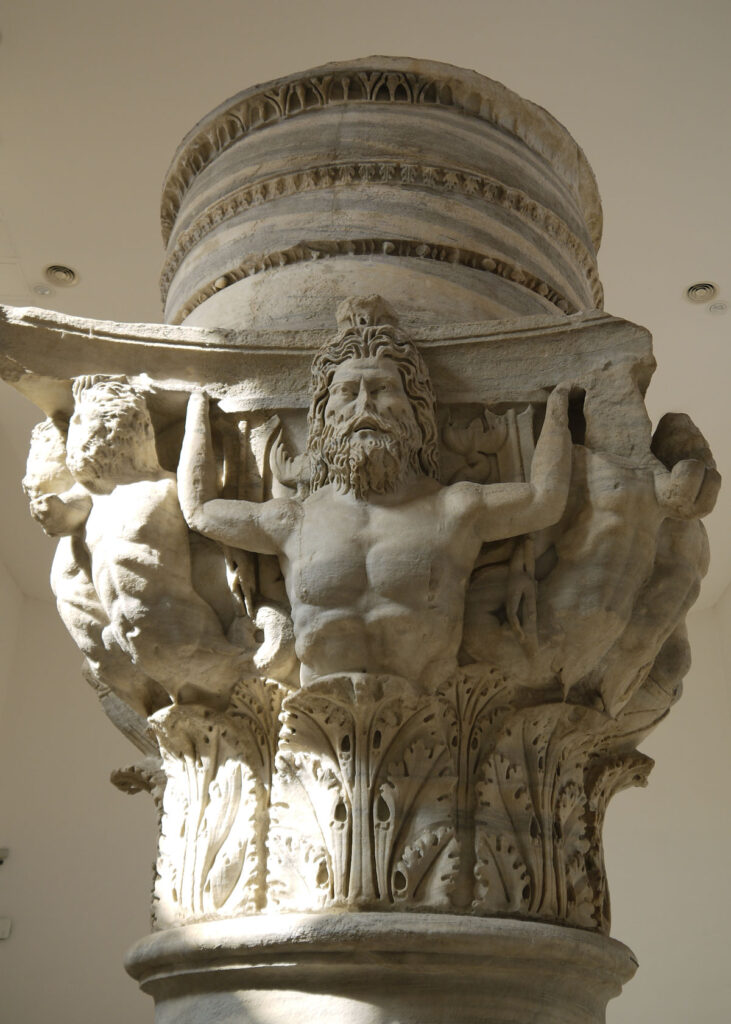
The capital is sculpted with majestic figures of gods and tritons. Among the wall displays is a 1776 painting of the port of Brindisi by Luigi Mayer which gives an idea of how the original two columns looked at that point in history.
On an upper floor of the palazzo are exhibition spaces, worth checking out if open. When I visited this hosted a temporary photography exhibition of scenes along the Appian Way.
Appian Way Column and waterfront
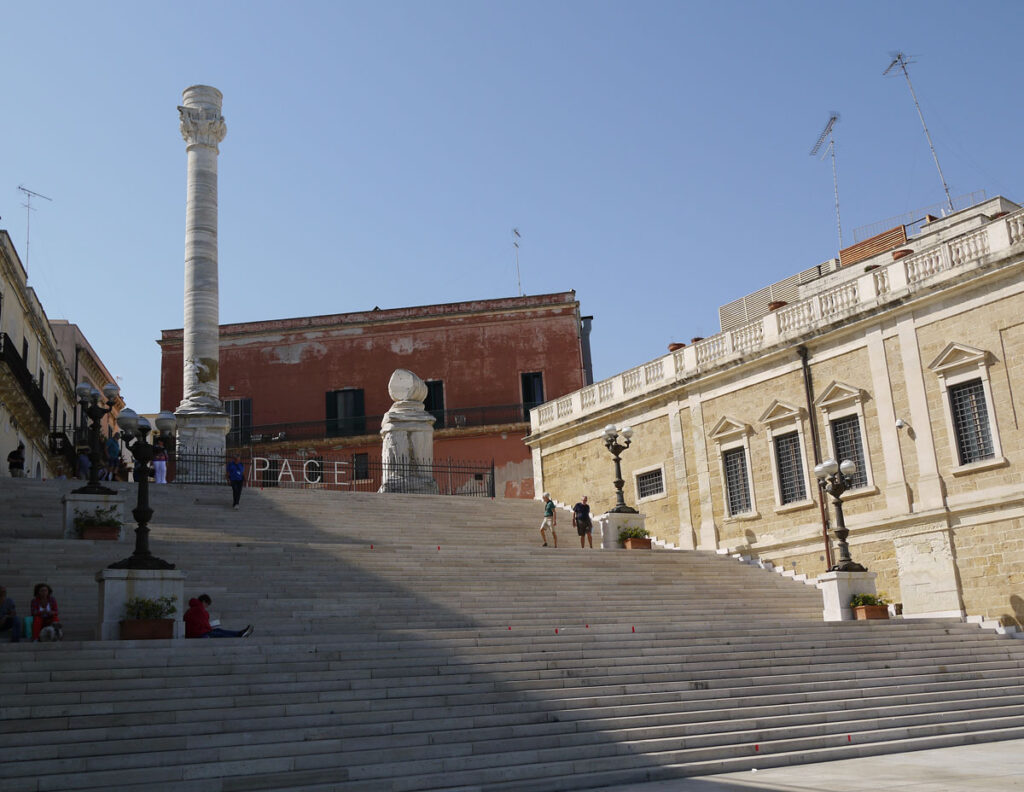
A visit to the remaining Appian Way column is top of the must-see list for all visitors to Brindisi. It combines well with a picturesque walk along the harbourside.
Brindisi’s principal straight boulevard, Corso Garibaldi, leads directly out to the waterfront of the inner harbour. Here you’ll find an attractive little green park, Piazza Vittorio Emanuele II. There’s another tourist information office over the road, a useful stop-off if you’re beginning your tour here. In the park is an elaborate 1980s monument in white Carrara marble to the Roman poet Virgil, who died in Brindisi in 19 BC, supposedly in a house by the end of the Appian Way. With stone benches, a fountain, palm and olive trees and a drinking-water tap, this pleasant piazza is a good place to enjoy a break or a gelato.
Turning left along the waterfront, the top of the famous Roman column is visible above rooftops before you reach its base. Like the stone capital, this surprised and impressed me with its scale. Other visitors may share the thrill I felt as I arrived at the foot of the steps crowned by the column. Years ago I lived in Rome on the Via Appia Nuova, and often on a Sunday I’d walk along the first few miles of the Appia Antica, the ancient Appian Way. Travelling along the start of the road, I was always conscious of its length, destination and significance, and would picture its famous ending-point here in Brindisi, always hoping to visit one day.
It’s said that the two great Roman columns overlooking Brindisi’s inner harbour were erected to mark the end of the Appian Way (Via Appia) or the Emperor Trajan’s later road, the Via Traiana, a faster alternative/extension to the Via Appia following a different route from Benevento to Brindisi. In fact, the columns’ original purpose doesn’t seem to be definitively known, but certainly for centuries they have represented Brindisi and the Appian Way.
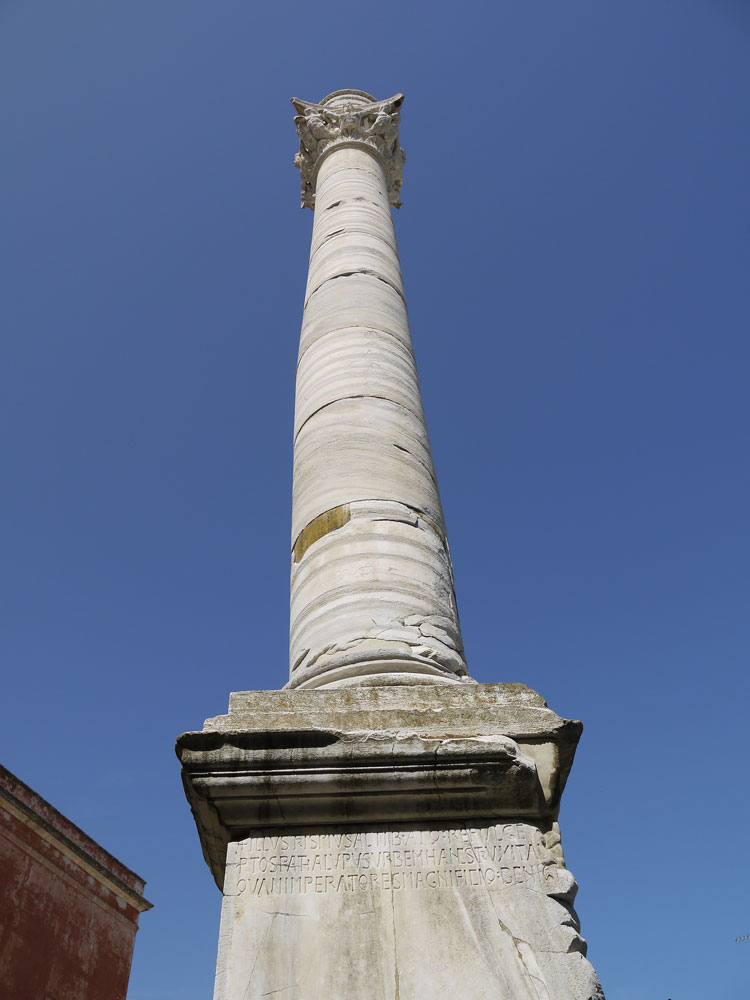
One of the columns collapsed in 1528, and in the following century most of its pieces were given to the town of Lecce, where they were reconstructed into a column dedicated to their saint, in thanks for Lecce’s deliverance from the plague. The surviving column in Brindisi was dismantled for safekeeping in WW2, and then taken apart again for restoration at the start of this century. Today it stands proudly in its dramatic elevated setting, with a replica capital to take the place of the original now displayed in Palazzo Granafei-Nervegna. Alongside is the base of the second column.
The view from here gives a great perspective on Brindisi and its strategic position, with the two arms of the inner harbour reaching around the city, and the narrow passage leading out towards the Adriatic sea. Protecting the outer harbour mouth beyond, you can see the island of Sant’Andrea and its fortress, the Castello Alfonsino. Behind the steps, a lane leads the short distance to the town’s cathedral, the Duomo.
The port in use for millennia – at least when it wasn’t blockaded or silted up – is now a relatively peaceful expanse of water, the modern working port moved out beyond its limits. The wide and attractive waterfront makes an enjoyable promenade on a sunny day. You may notice ‘bus stops’ alongside the water – the city bus company STP runs boats which cross the harbour from here.
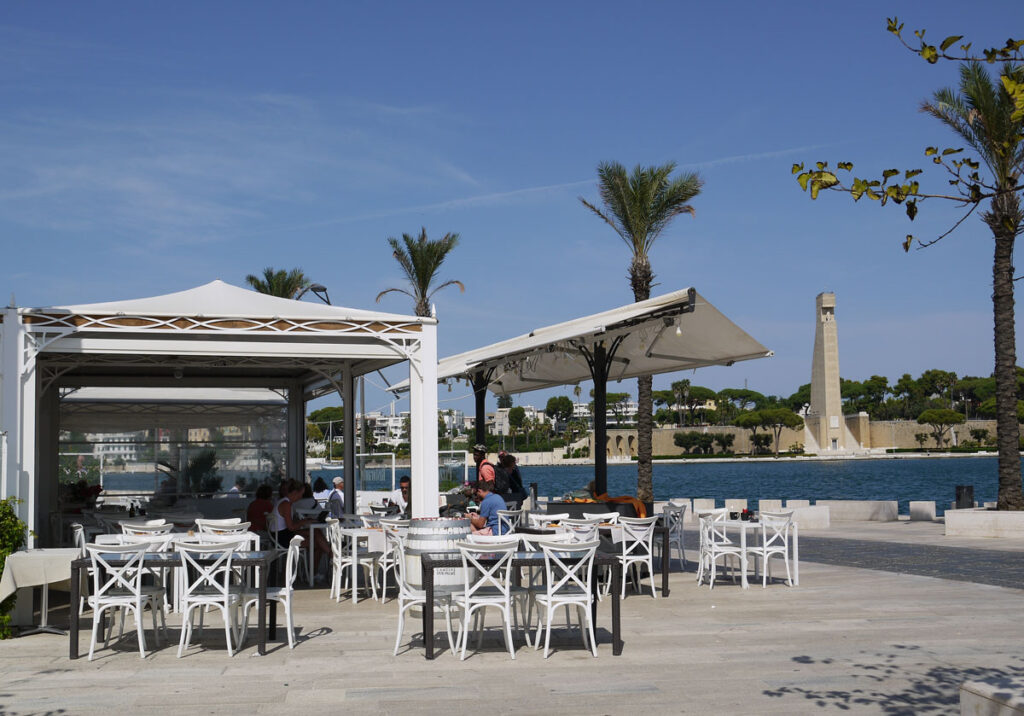
The small waterbuses cross the strait to the tall white monument you can see over the harbour, the Monumento al Marinaio d’Italia. In a form modelled on a ship’s rudder, this Mussolini-era structure was completed in 1933 and commemorates the sailors who died in the First World War. With great views from the top, the monument is a tourist attraction (admission fee, closed Wednesdays). A short distance along the waterfront from the monument, and another waterbus destination, is an interesting 20th-century purpose-built fishing village, the Villaggio Pescatori.
Continuing the seaside stroll from the Roman column, past café tables and views, other sights include the Casa del Turista, on the site of a church complex connected with the Knights Templar and other orders, a reminder of the port’s importance to Mediterranean travel.
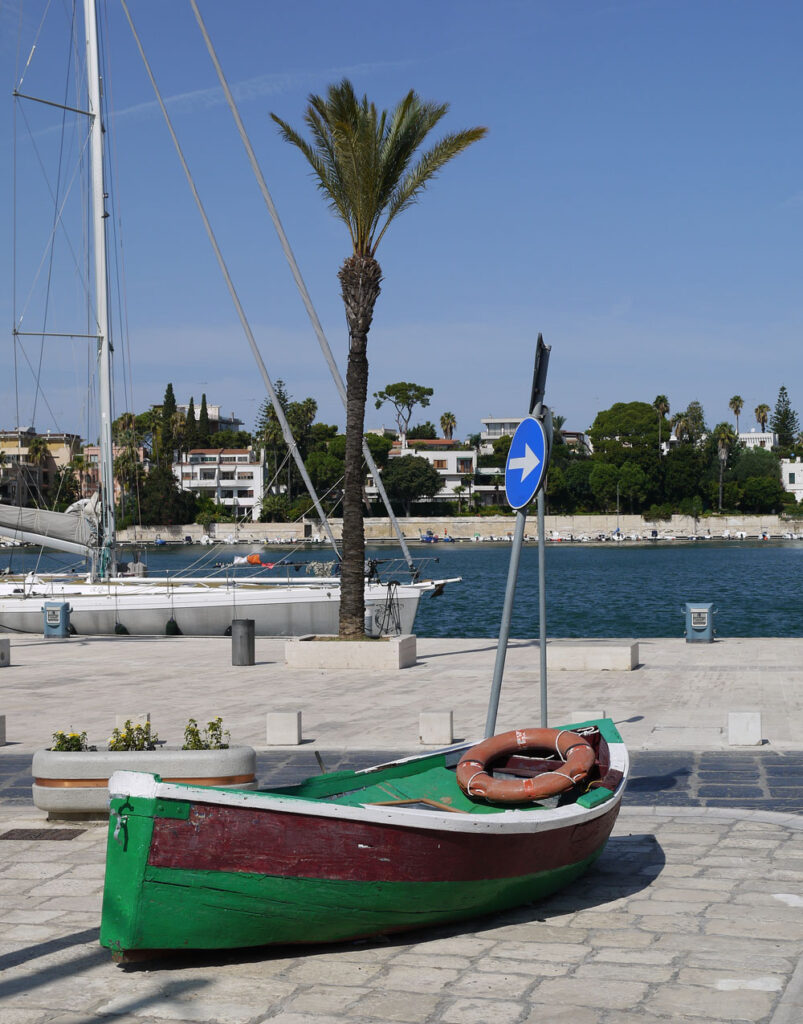
Broad flights of steps from the harbourside ascend to Piazza Santa Teresa, an impressive tree-lined square with views. Its focal point is a large Great War monument (dedicated from ‘Brindisi ai suoi figli caduti per la Patria 1915-1918’). The city’s coat of arms, which features the two Roman columns, is laid out in a mosaic in the centre of the piazza. In a city centre without many notable preserved buildings, the fine Baroque façade of the church of Santa Teresa stands out.
Museo Diocesano
Just down the road from Piazza Santa Teresa is Brindisi’s Museo Diocesano Giovanni Tarantini (Diocesan Museum). Collections of artworks and valuables from churches aren’t always among a town’s best sights, but this museum is really worth visiting. It’s housed in the former church of San Paolo Eremita, is free to enter (donations welcome) and has a range of interesting exhibits well-presented in an airy space.
The church itself is a sight worth seeing; a fascinating snapshot of changing times. Along its walls are grand Baroque altars – cherubs, wood, elaborate stonework – with 14th-century frescoes partly uncovered behind. I found this visual demonstration of changing fashions in church decoration compelling.
Among the art on display is a painting of one of southern Italy’s most curious saints: San Giuseppe of Copertino, the flying monk. The painting has been moved from its altar setting to display the damaged earlier frescoes behind.
The most rich and fascinating object here is the 13th-century silver-panelled reliquary of St Theodore known as the Arca di San Teodoro. This fabulous chest is covered in elaborate scenes of the saint’s life and afterlife, including horseback dragon-slaying, and the arrival of the saint’s holy corpse in Brindisi by ship, with the city’s town walls and two Roman columns clearly depicted.
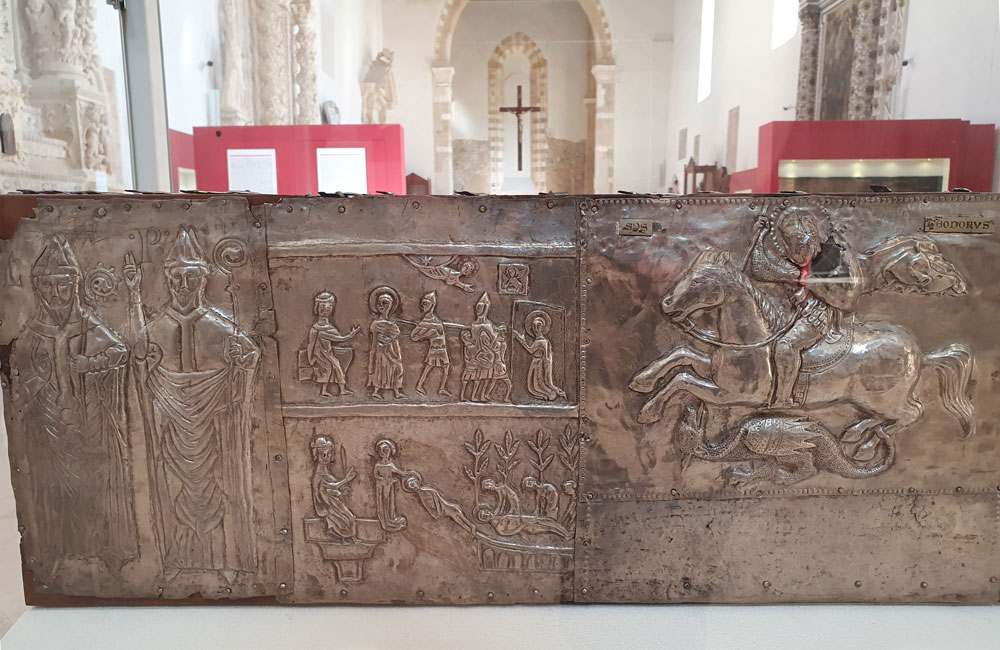
In a side room you’ll find a collection of twelve skulls dressed in white linen and richly-decorated red damask. These are said to be the relics of the martyred virgin companions of St Ursula, brought from Cologne by 17th-century local churchman and saint St Lawrence of Brindisi. Another exhibit with hopeful religious associations is a stone jar, carved from serpentine and perhaps brought back from the Crusades, which was once claimed to be one of the stone vessels from the wedding at Cana in which Jesus turned water into wine.
When I visited this excellent free museum containing so much of the city’s religious heritage, I found a sad scene. Many of the cases were occupied only by A4 printed sheets with the message ‘The photos reproduce the objects stolen from this museum on 18 March 2023’. Almost all the historic silverware had been taken by thieves, apart from the large reliquary, including a chalice that was carried in an annual procession. Hopefully the stolen items may have been recovered, as these treasures sometimes are, by the time you visit.
Check opening times: Museo Diocesano G Tarantini
Archeological Area of San Pietro degli Schiavoni
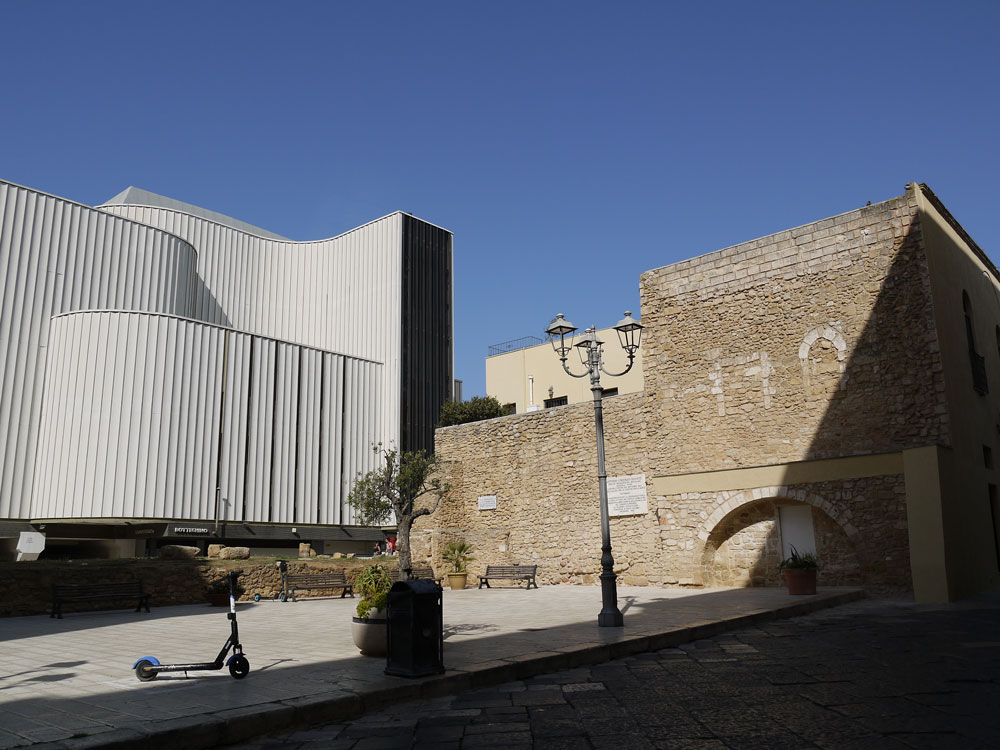
This archaeological area is an unexpected window into Brindisi’s long past, right over the road from Palazzo Granafei-Nervegna. If I hadn’t been told about it in the tourist information office, I may never have known it was there. In the subterranean space underneath the undulating contemporary designs of the Nuovo Teatro Verdi is a district of Roman Brundisium (free entry, check opening hours in advance).
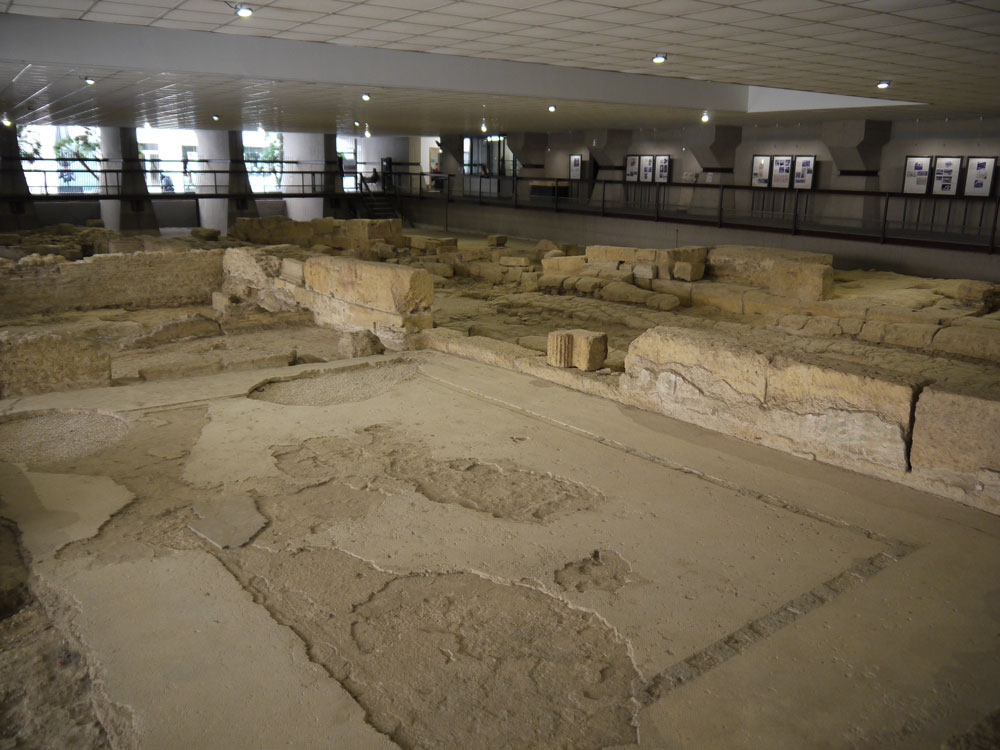
Extending below the theatre building is a stretch of road, an exposed archaeological area with a domus, mosaic flooring of simple black and white tesserae, remains of baths, plumbing, columns and more. As most of today’s Brindisi is fairly modern, it’s quite exciting to get this opportunity to look at the Roman city underneath. The later historic layers of most Italian towns, while attractive, mean there’s usually a limit to how much ancient history can be excavated and exposed to view. After I’d walked around the site, the custodians and friends chatting outside were eager to direct me to the Duomo, keen I should see the best of their city.
Duomo
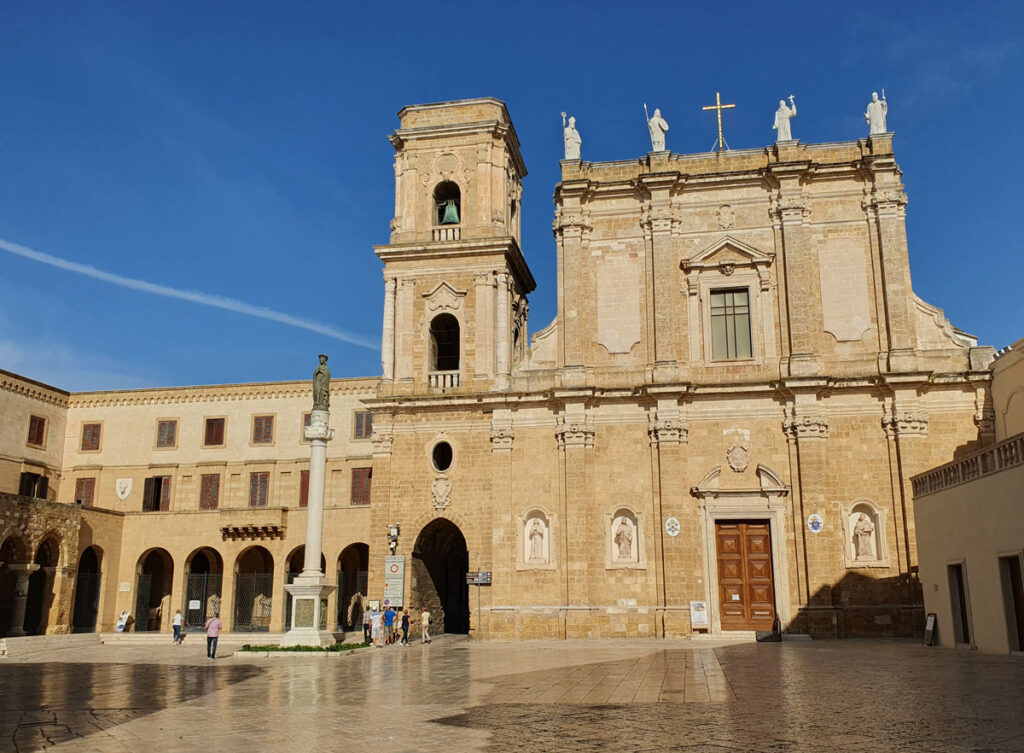
Turning the corner into Brindisi’s Piazza Duomo comes as a surprise to the visitor expecting an unappealing modern port city. With its shiny stone paving and golden historic buildings, this small unpretentious square is really unexpectedly pretty, especially in sunshine under a blue sky. Brindisi’s cathedral, the Duomo or Cattedrale, was mostly constructed from the 17th century onwards, but is on the site of a much earlier church, scene of the coronation and wedding of the short-lived Roger III of Sicily, and later of Emperor Frederick II’s 1225 wedding to his 14-year-old bride Isabella (Yolanda) de Brienne of Jerusalem.
The cathedral’s short, stubby but elegant campanile was damaged by Allied bombing in WW2 but restored to its previous design. A triangular pediment added in the 1920s was replaced by statues of saints in 1957. The building’s interior is fairly simple. A painted cartapesta (papier-mâché) statue of San Teodoro, carried in religious processions, and fragments of a 12th-century mosaic paving are among its sights.
Brindisi Archaeological Museum: Museo Archeologico Francesco Ribezzo
Brindisi’s archaeological museum has some fantastic exhibits in its collection, and is free to visit. For anyone with an interest in Puglia’s ancient history, it’s a must-visit. Remarkably, and sadly, I saw a staff member outside trying unsuccessfully to interest tourists in visiting (“it’s free”). I was welcomed with enthusiasm when I entered. The archaeological museum is alongside the Duomo, through an arched colonnade.
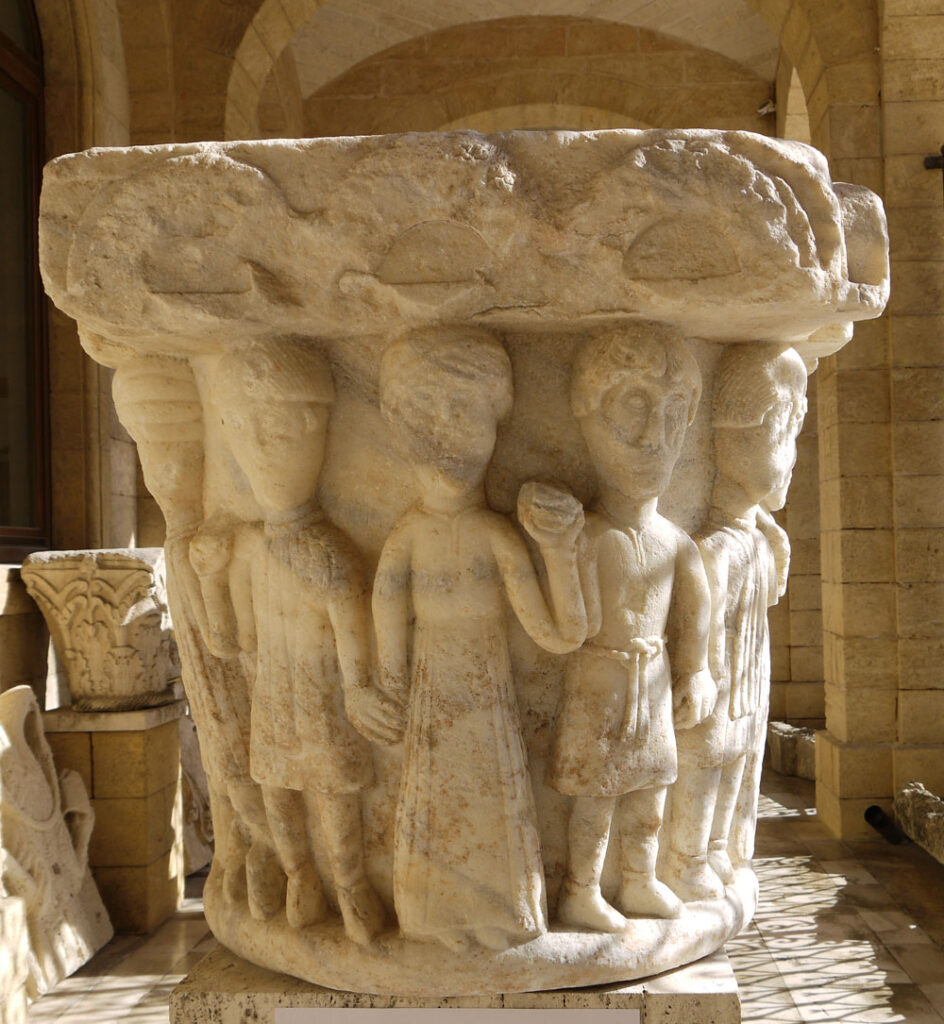
One of the most memorable objects on display isn’t in the museum itself but in the colonnaded loggia outside. The medieval Capitello della Danza dates to Puglia’s Norman epoch; a delightful 11th-century column capital from a now-vanished Benedictine abbey on the offshore island of Sant’Andrea. The marble is carved with a chain of dancers, hand in hand, full of the sense of movement and the joy of dance; I had seen similar dancing a few days earlier on the waterfront in Monopoli, and found this sculpture and its timelessness incredibly charming
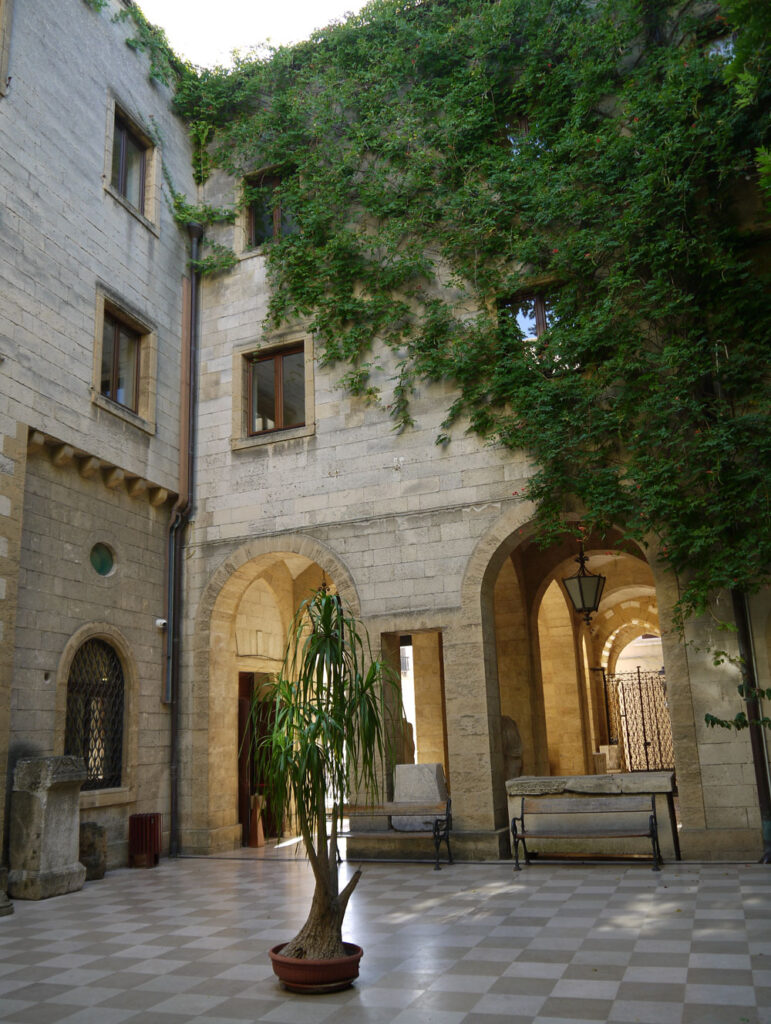
Inside, through a pretty courtyard, the museum is spread over several floors. There’s a lot to see if you have time for a thorough tour: a golden plaque with a late-ancient magical inscription, fine vases, terracotta antefixes, lovely Roman glassware, obsidian artefacts, a basement room of headless sculptures and epigraphs with inscriptions in Hebrew and in the language of the pre-Greek local Messapian culture. The fine sculptures on display include capitals sculpted with heads and the statue of a boy as Hercules.
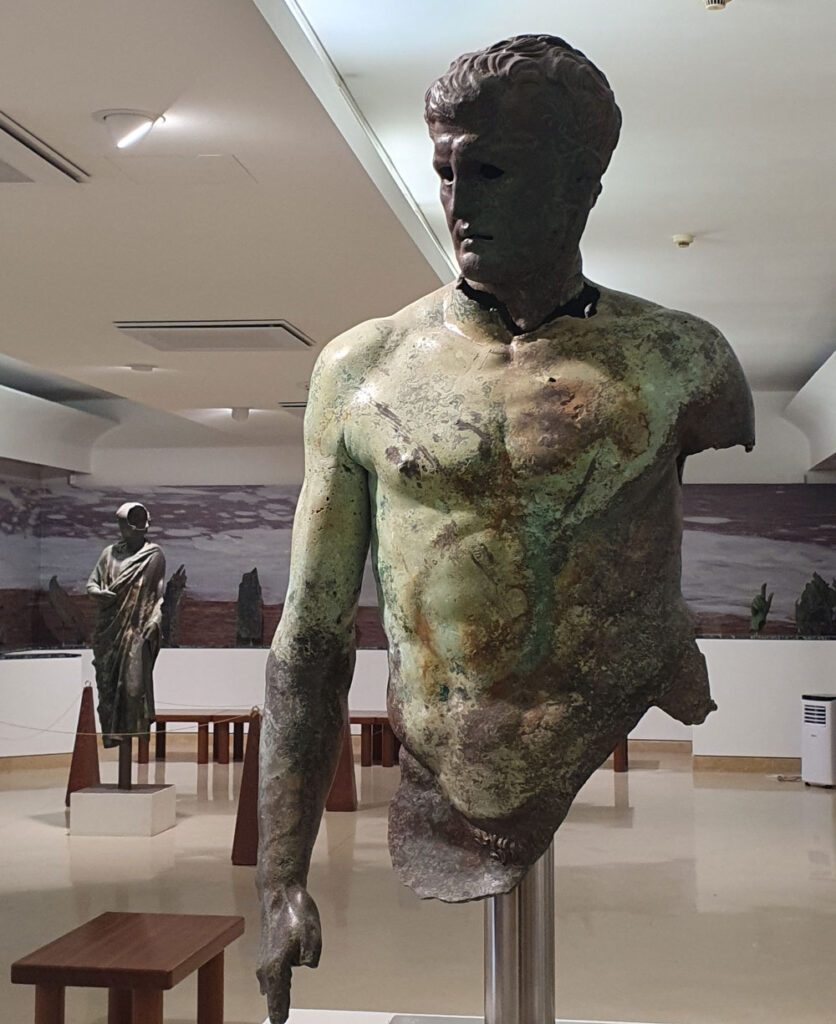
The biggest wow factor comes from the underwater archaeology section and a collection of bronze sculptural fragments discovered on the seabed near Punta del Serrone in the 1990s. Large and small, these include busts, arms, hands, locks and more.
Other highlights of the museum include the model of a ship containing a display of amphorae and a mosaic of Theseus and the Cretan Labyrinth. When I visited there was some information in English, but most of the detail and the labels were in Italian. Opening times, events and information: https://www.facebook.com/MuseoRibezzo
Tempio di San Giovanni al Sepolcro
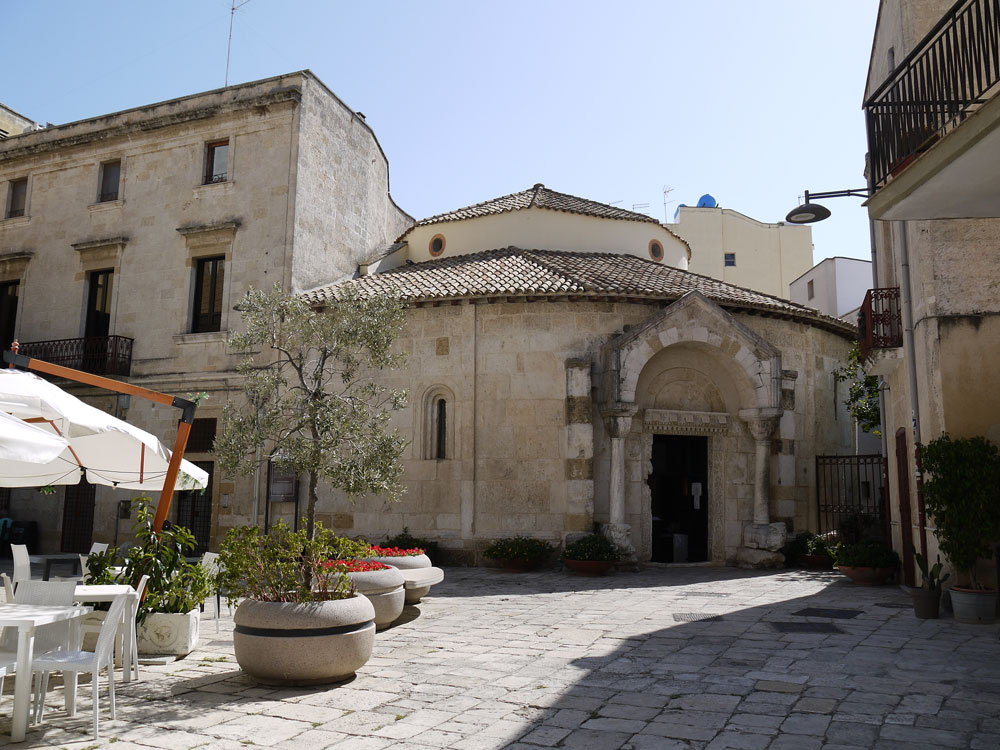
Another unexpected and charming sight of Brindisi is the round Tempio di San Giovanni al Sepolcro. Constructed in the 11th or early 12th century and inspired by the Church of the Holy Sepulchre in Jerusalem, this remarkable old church is a reminder of Brindisi’s close connections with the Holy Land. During my tour of Brindisi this was the only site with an entrance fee, but it was modest and well worth it. This glorious old building is entered between columns supported by worn lions, between doorposts bearing fine carvings with religious symbolism. Inside it reminded me very much of Santo Stefano Rotondo in Rome, on a smaller scale.
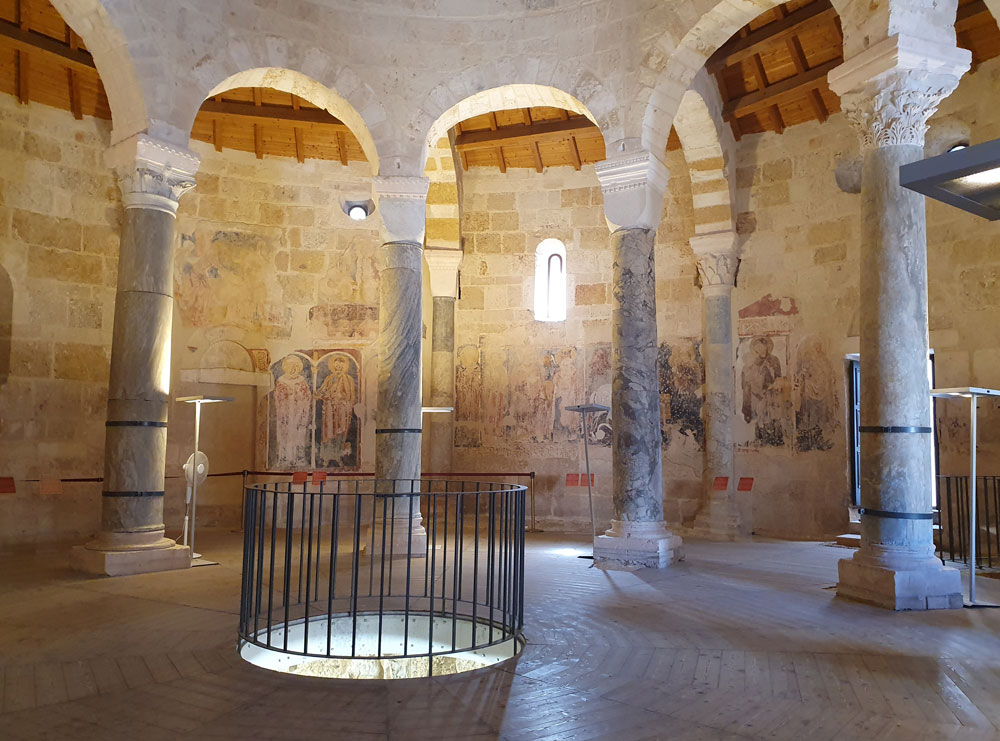
The circular interior of the church is very atmospheric. Light falls through arches and columns. On the walls are faded frescoes, some of them revealing earlier frescoes beneath. The earliest of these date to the 13th or 14th century. In one section of wall St George appeared to be riding a horse with two rear ends; the later fresco was painted over the earlier one and changed some of the details including the saint’s direction of travel.
Through a central hole in the paving you can see the tesserae flooring of a Roman house which previously stood on this site. Althought the building as it stands today appears simple and uncluttered, it’s a good place to take your time studying details and absorbing the atmosphere. I enjoyed looking at the frescoes and the stone carvings filled with medieval meaning: fruit, plants, beasts. Other symbols carved into the walls include Solomon’s Knot. Accessed through the church is another surprise: a magical garden in the heart of the city: a stone well, trees, pomegranantes.
More sights, food and drink
One of the finest tourist sights of the Brindisi area is just outside the town centre. The remarkable fresco-filled church of Santa Maria del Casale is now marooned on the boundary of the airport. You can reach it by the airport bus, and travellers flying from the airport can take a short walk there after checking in. I’ve written about it on my airport page: Brindisi Airport.
I found my 24 hours in Brindisi were pleasantly full, but if you have more time or different priorities, other sights to visit include those over the water described above, the Monumento al Marinaio d’Italia and the purpose built fishing village.
Many of Brindisi’s old defences remain more-or-less standing: some of the bastions and town walls can be seen from the airport bus ride. Along the perimeter of the historic centre is the Porta Mesagne, Brindisi’s oldest surviving town gateway, which dates to the 13th century and was built on foundations of Roman defences. The large stone monumental fountain called the Fontana Tancredi was built in honour of the wedding of Roger, son of Tancredi, King of Sicily.
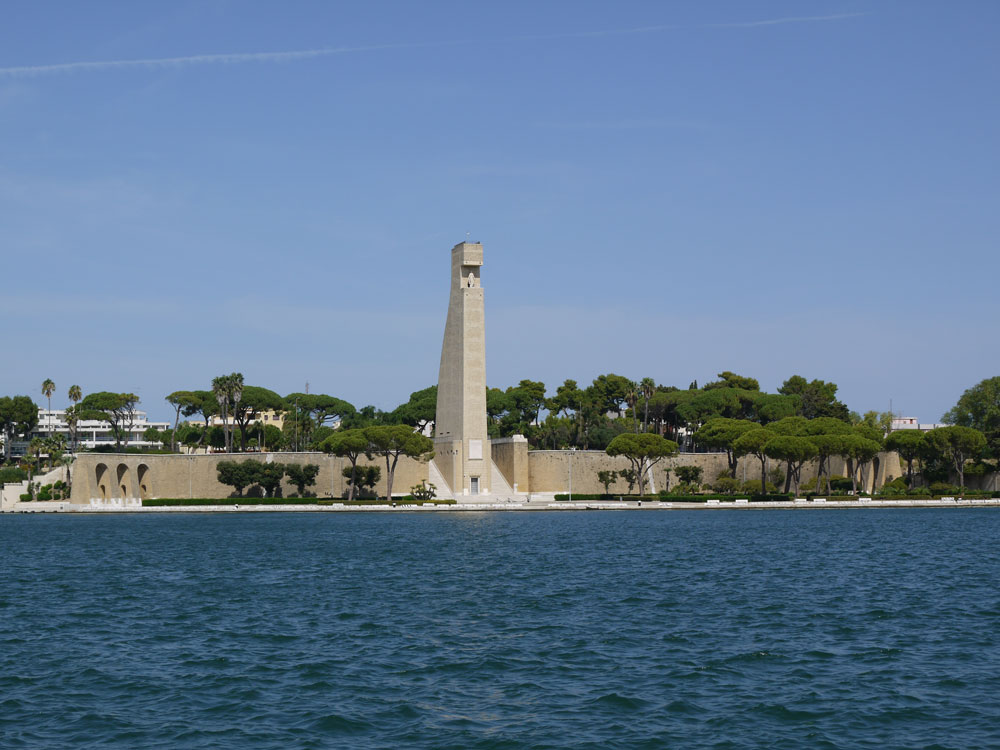
Brindisi’s two mighty fortresses are the Castello Svevo and the Castello Alfonsino. The Castello Svevo (Swabian Castle) which looms over the town centre from its harbourside position, was the setting for a dinner of world leaders during the G7 summit in Puglia in 2024. Still a military base and in the hands of the Italian navy, it can only be seen from the outside. The island fortress Castello Alfonsino, out beyond the harbour on the Isola di Sant’Andrea, is visitable at the time of writing on guided tours: Castello Alfonsino (Facebook)
I had a delicious dinner in Brindisi at the Enoteca Ristorante Penny, a smart and welcoming little restaurant with vaulted ceilings, walls lined with bottles of wine and a few outdoor tables. Local ingredients and wines like my glass of Susumaniello rosato combine modernity with tradition and a sense of place.
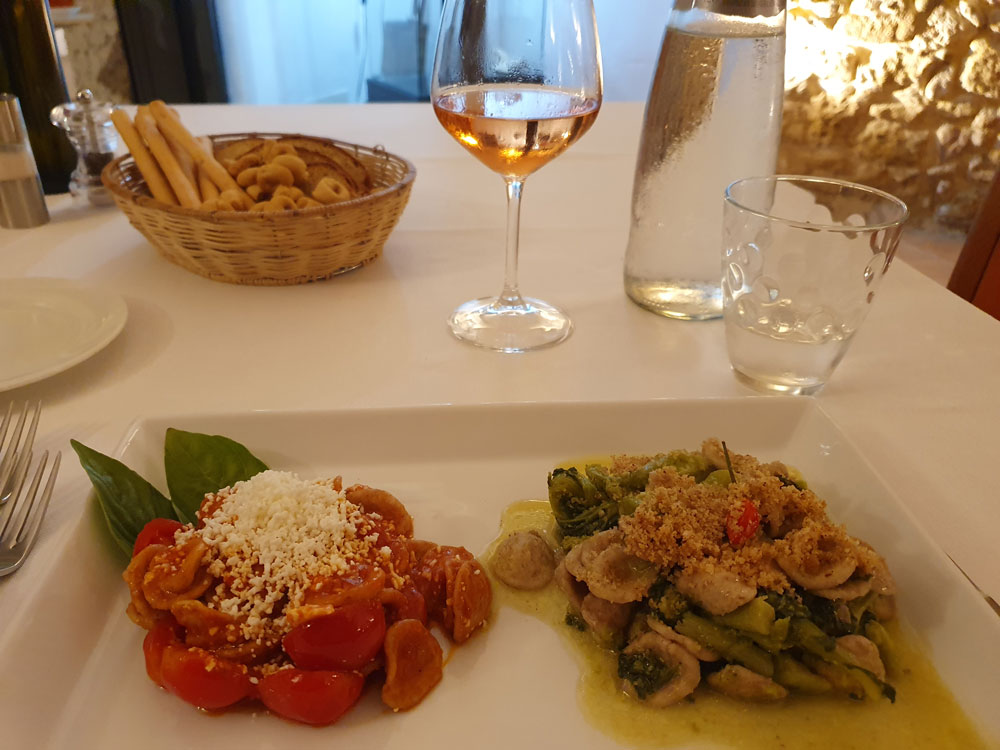
Along the main strreet Corso Garibaldi and down its side streets you’ll find a range of cafés, bars and restaurants – not a huge selection, but enough to offer visitors some tempting choices. Unsurprisingly, you’ll find a lot of seafood, as well as traditional local dishes like orecchiette pasta and seasonal vegetables. For fast food, fishy-style, head to La Barracchina del Porto City, a popular counter on the corner of Piazza Vittorio Emanuele II, where street food options include octopus panini.
Brindisi travel and public transport
Brindisi is well-connected by air, train and bus. Flights from a number of European destinations use the smallish Brindisi airport; it’s the most convenient airport for reaching the Salento and Puglia’s south. A local town bus connects the airport with the city centre. If you’re planning a touring itinerary it can make sense and save travel time to do what I do: fly into one of Puglia’s airports, Bari airport or Brindisi, and out of the other.
Direct trains connect Brindisi with both local destinations and major Italian cities. Lecce is half an hour away by cheap regional train, and in the other direction Bari is an hour and a quarter’s journey (stops in between include Monopoli and Polignano a Mare). Ostuni station is a 20-minute train ride away, though travellers will then need to take a bus or taxi into Ostuni town centre.
Brindisi’s railway station is convenient for the town centre. From Piazza Crispi in front of the station it’s a straight walk up Corso Umberto I and then Corso Garibaldi to reach the waterfront at Piazza Vittorio Emanuele II; turn left for the Colonna. The other sights of the town centre can be reached by heading left earlier, at Piazza Vittoria.
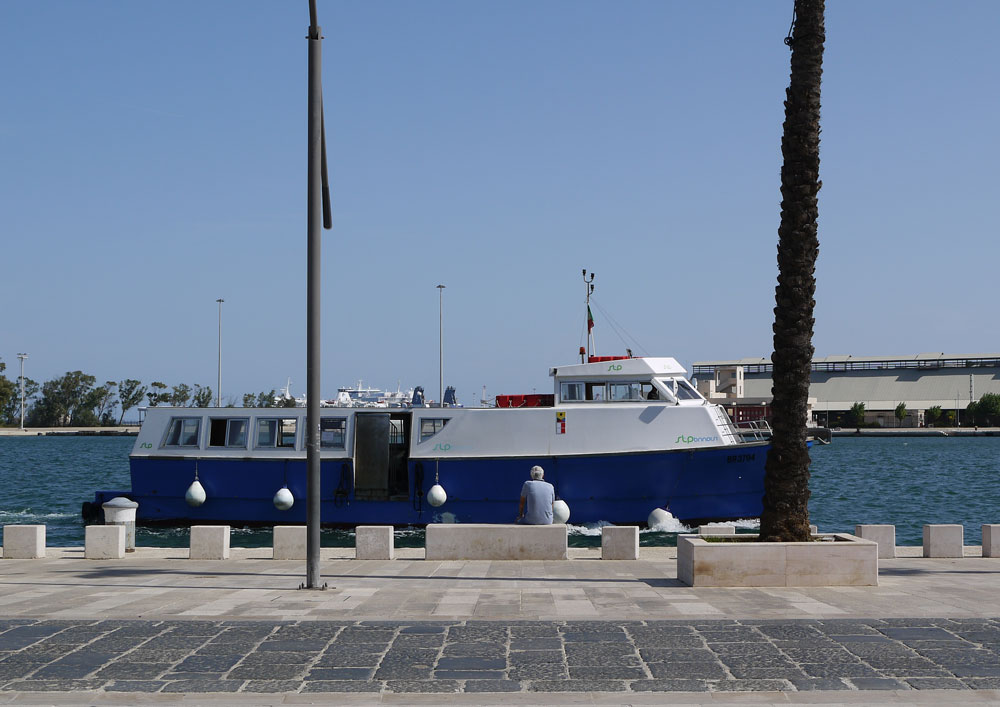
The bus to Brindisi airport runs around the town,with a stop by the waterfront at Via del Mare and another by the station. On the way it passes sections of the town’s old defensive walls and bastians and defences, as well as some of the poorer areas of the town outside the centre.
